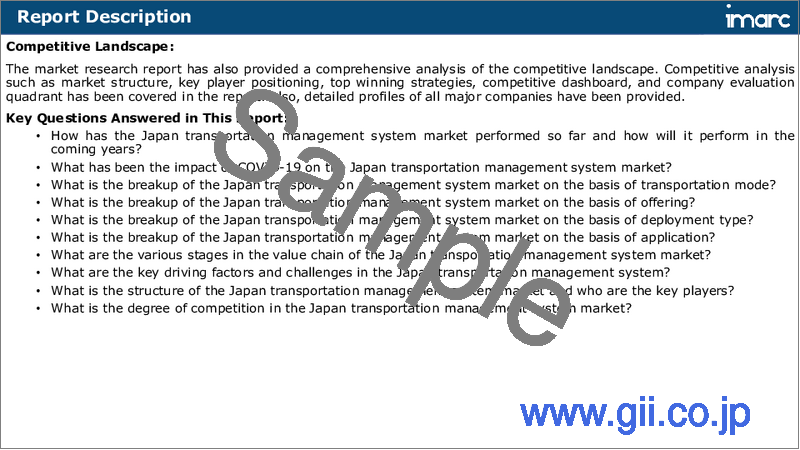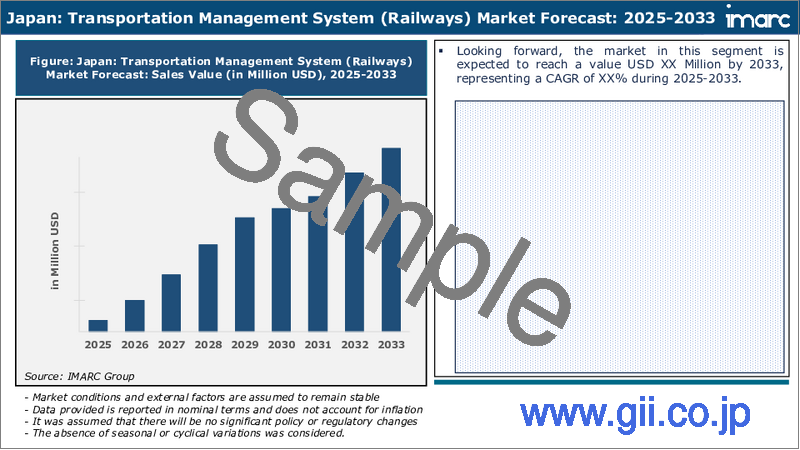|
|
市場調査レポート
商品コード
1609750
日本の輸送管理システム市場レポート:輸送モード、提供、展開タイプ、用途、地域別、2025年~2033年Japan Transportation Management System Market Report by Transportation Mode, Offering, Deployment Type, Application, and Region 2025-2033 |
||||||
カスタマイズ可能
|
|||||||
| 日本の輸送管理システム市場レポート:輸送モード、提供、展開タイプ、用途、地域別、2025年~2033年 |
|
出版日: 2024年12月05日
発行: IMARC
ページ情報: 英文 118 Pages
納期: 5~7営業日
|
全表示
- 概要
- 目次
日本の輸送管理システム市場の市場規模は2024年に10億4,160万米ドルに達しました。今後、IMARC Groupは、市場は2033年までに36億5,990万米ドルに達し、2025年から2033年にかけて15.1%の成長率(CAGR)を示すと予測しています。eコマース分野の拡大により、商品の移動を管理し、タイムリーな配送を確保するための効率的な輸送ソリューションへの需要が高まっており、これが市場を牽引しています。
本レポートで扱う主な質問
- 日本の輸送管理システム市場はこれまでどのように推移し、今後どのように推移するのか?
- COVID-19が日本の輸送管理システム市場に与えた影響は?
- 日本の輸送管理システム市場の輸送モード別の内訳は?
- 日本の輸送管理システム市場の提供別の内訳は?
- 日本の輸送管理システム市場の展開タイプ別の内訳は?
- 日本の輸送管理システム市場の用途別の内訳は?
- 日本の輸送管理システム市場のバリューチェーンにはどのような段階がありますか?
- 日本の輸送管理システムにおける主な促進要因と課題は何か?
- 日本の輸送管理システム市場の構造と主要プレーヤーは?
- 日本の輸送管理システム市場における競合の程度は?
目次
第1章 序文
第2章 調査範囲と調査手法
- 調査の目的
- ステークホルダー
- データソース
- 市場推定
- 調査手法
第3章 エグゼクティブサマリー
第4章 日本の輸送管理システム市場:イントロダクション
- 概要
- 市場力学
- 業界動向
- 競合情報
第5章 日本の輸送管理システム市場情勢
- 過去および現在の市場動向(2019年~2024年)
- 市場予測(2025-2033)
第6章 日本の輸送管理システム市場:輸送モード別の内訳
- 鉄道
- 道路
- 航空
- 水路
第7章 日本の輸送管理システム市場:提供別の内訳
- ソフトウェア
- ハードウェア
- サービス
第8章 日本の輸送管理システム市場:展開タイプ別の内訳
- オンプレミス
- クラウドベース
第9章 日本の輸送管理システム市場:用途別の内訳
- 小売業とeコマース
- 製造
- ロジスティクス
- 政府機関
- ヘルスケア
- 旅行と観光
- その他
第9章 日本の輸送管理システム市場:競合情勢
- 概要
- 市場構造
- 市場プレーヤーのポジショニング
- 主要成功戦略
- 競合ダッシュボード
- 企業評価象限
第10章 主要企業のプロファイル
第11章 日本の輸送管理システム市場:業界分析
- 促進要因・抑制要因・機会
- ポーターのファイブフォース分析
- バリューチェーン分析
第12章 付録
Japan transportation management system market size reached USD 1,041.6 Million in 2024. Looking forward, IMARC Group expects the market to reach USD 3,659.9 Million by 2033, exhibiting a growth rate (CAGR) of 15.1% during 2025-2033. The expanding e-commerce sector, which increases the demand for efficient transportation solutions for managing the movement of goods and ensuring timely deliveries, is driving the market.
A transportation management system (TMS) is a comprehensive software solution that facilitates the efficient planning, execution, and optimization of freight movement within a supply chain. It serves as a central hub for managing various transportation-related activities, including route planning, carrier selection, shipment tracking, and performance analysis. TMS enables businesses to streamline their logistics operations, enhance visibility into the supply chain, and ultimately reduce transportation costs. Key functionalities of a TMS include automated order processing, real-time tracking, route optimization, and freight rate management. It empowers organizations to make data-driven decisions, improve delivery timelines, and enhance overall customer satisfaction. By integrating with other supply chain components, such as inventory management and warehouse systems, a TMS contributes to achieving a synchronized and efficient end-to-end supply chain process. In essence, a TMS plays a pivotal role in modern logistics, offering a centralized platform to enhance visibility, control, and efficiency in managing the complexities of transportation networks.
Japan Transportation Management System Market Trends:
The transportation management system market in Japan is experiencing robust growth driven by several key factors. Firstly, the rising complexity of logistics networks necessitates advanced technology to optimize routing, scheduling, and overall operational efficiency. In addition to this, the escalating demand for real-time visibility and tracking capabilities is propelling the TMS market forward. This is particularly crucial in a dynamic business environment where timely information about shipments is essential for decision-making. Furthermore, the growing emphasis on sustainability and environmental concerns is steering organizations towards TMS solutions that can help minimize fuel consumption and reduce carbon footprints through optimized route planning. Furthermore, the integration of artificial intelligence and machine learning in TMS is a significant driver, enabling predictive analytics for better decision-making and resource optimization. This, coupled with the increasing adoption of cloud-based TMS solutions, enhances scalability and flexibility for businesses. In essence, the confluence of these drivers is reshaping the landscape of the TMS market in Japan, creating a compelling trajectory for its continued expansion.
Japan Transportation Management System Market Segmentation:
Transportation Mode Insights:
- Railways
- Roadways
- Airways
- Waterways
Offering Insights:
- Software
- Hardware
- Services
Deployment Type Insights:
- On-Premises
- Cloud-based
Application Insights:
- Retail and E-commerce
- Manufacturing
- Logistics
- Government Organizations
- Healthcare
- Travel and Tourism
- Others
Competitive Landscape:
The market research report has also provided a comprehensive analysis of the competitive landscape. Competitive analysis such as market structure, key player positioning, top winning strategies, competitive dashboard, and company evaluation quadrant has been covered in the report. Also, detailed profiles of all major companies have been provided.
Key Questions Answered in This Report:
- How has the Japan transportation management system market performed so far and how will it perform in the coming years?
- What has been the impact of COVID-19 on the Japan transportation management system market?
- What is the breakup of the Japan transportation management system market on the basis of transportation mode?
- What is the breakup of the Japan transportation management system market on the basis of offering?
- What is the breakup of the Japan transportation management system market on the basis of deployment type?
- What is the breakup of the Japan transportation management system market on the basis of application?
- What are the various stages in the value chain of the Japan transportation management system market?
- What are the key driving factors and challenges in the Japan transportation management system?
- What is the structure of the Japan transportation management system market and who are the key players?
- What is the degree of competition in the Japan transportation management system market?
Table of Contents
1 Preface
2 Scope and Methodology
- 2.1 Objectives of the Study
- 2.2 Stakeholders
- 2.3 Data Sources
- 2.3.1 Primary Sources
- 2.3.2 Secondary Sources
- 2.4 Market Estimation
- 2.4.1 Bottom-Up Approach
- 2.4.2 Top-Down Approach
- 2.5 Forecasting Methodology
3 Executive Summary
4 Japan Transportation Management System Market - Introduction
- 4.1 Overview
- 4.2 Market Dynamics
- 4.3 Industry Trends
- 4.4 Competitive Intelligence
5 Japan Transportation Management System Market Landscape
- 5.1 Historical and Current Market Trends (2019-2024)
- 5.2 Market Forecast (2025-2033)
6 Japan Transportation Management System Market - Breakup by Transportation Mode
- 6.1 Railways
- 6.1.1 Overview
- 6.1.2 Historical and Current Market Trends (2019-2024)
- 6.1.3 Market Forecast (2025-2033)
- 6.2 Roadways
- 6.2.1 Overview
- 6.2.2 Historical and Current Market Trends (2019-2024)
- 6.2.3 Market Forecast (2025-2033)
- 6.3 Airways
- 6.3.1 Overview
- 6.3.2 Historical and Current Market Trends (2019-2024)
- 6.3.3 Market Forecast (2025-2033)
- 6.4 Waterways
- 6.4.1 Overview
- 6.4.2 Historical and Current Market Trends (2019-2024)
- 6.4.3 Market Forecast (2025-2033)
7 Japan Transportation Management System Market - Breakup by Offering
- 7.1 Software
- 7.1.1 Overview
- 7.1.2 Historical and Current Market Trends (2019-2024)
- 7.1.3 Market Forecast (2025-2033)
- 7.2 Hardware
- 7.2.1 Overview
- 7.2.2 Historical and Current Market Trends (2019-2024)
- 7.2.3 Market Forecast (2025-2033)
- 7.3 Services
- 7.3.1 Overview
- 7.3.2 Historical and Current Market Trends (2019-2024)
- 7.3.3 Market Forecast (2025-2033)
8 Japan Transportation Management System Market - Breakup by Deployment Type
- 8.1 On-Premises
- 8.1.1 Overview
- 8.1.2 Historical and Current Market Trends (2019-2024)
- 8.1.3 Market Forecast (2025-2033)
- 8.2 Cloud-based
- 8.2.1 Overview
- 8.2.2 Historical and Current Market Trends (2019-2024)
- 8.2.3 Market Forecast (2025-2033)
9 Japan Transportation Management System Market - Breakup by Application
- 9.1 Retail and E-commerce
- 9.1.1 Overview
- 9.1.2 Historical and Current Market Trends (2019-2024)
- 9.1.3 Market Forecast (2025-2033)
- 9.2 Manufacturing
- 9.2.1 Overview
- 9.2.2 Historical and Current Market Trends (2019-2024)
- 9.2.3 Market Forecast (2025-2033)
- 9.3 Logistics
- 9.3.1 Overview
- 9.3.2 Historical and Current Market Trends (2019-2024)
- 9.3.3 Market Forecast (2025-2033)
- 9.4 Government Organizations
- 9.4.1 Overview
- 9.4.2 Historical and Current Market Trends (2019-2024)
- 9.4.3 Market Forecast (2025-2033)
- 9.5 Healthcare
- 9.5.1 Overview
- 9.5.2 Historical and Current Market Trends (2019-2024)
- 9.5.3 Market Forecast (2025-2033)
- 9.6 Travel and Tourism
- 9.6.1 Overview
- 9.6.2 Historical and Current Market Trends (2019-2024)
- 9.6.3 Market Forecast (2025-2033)
- 9.7 Others
- 9.7.1 Historical and Current Market Trends (2019-2024)
- 9.7.2 Market Forecast (2025-2033)
9 Japan Transportation Management System Market - Competitive Landscape
- 9.1 Overview
- 9.2 Market Structure
- 9.3 Market Player Positioning
- 9.4 Top Winning Strategies
- 9.5 Competitive Dashboard
- 9.6 Company Evaluation Quadrant
10 Profiles of Key Players
- 10.1 Company A
- 10.1.1 Business Overview
- 10.1.2 Product Portfolio
- 10.1.3 Business Strategies
- 10.1.4 SWOT Analysis
- 10.1.5 Major News and Events
- 10.2 Company B
- 10.2.1 Business Overview
- 10.2.2 Product Portfolio
- 10.2.3 Business Strategies
- 10.2.4 SWOT Analysis
- 10.2.5 Major News and Events
- 10.3 Company C
- 10.3.1 Business Overview
- 10.3.2 Product Portfolio
- 10.3.3 Business Strategies
- 10.3.4 SWOT Analysis
- 10.3.5 Major News and Events
- 10.4 Company D
- 10.4.1 Business Overview
- 10.4.2 Product Portfolio
- 10.4.3 Business Strategies
- 10.4.4 SWOT Analysis
- 10.4.5 Major News and Events
- 10.5 Company E
- 10.5.1 Business Overview
- 10.5.2 Product Portfolio
- 10.5.3 Business Strategies
- 10.5.4 SWOT Analysis
- 10.5.5 Major News and Events
11 Japan Transportation Management System Market - Industry Analysis
- 11.1 Drivers, Restraints, and Opportunities
- 11.1.1 Overview
- 11.1.2 Drivers
- 11.1.3 Restraints
- 11.1.4 Opportunities
- 11.2 Porters Five Forces Analysis
- 11.2.1 Overview
- 11.2.2 Bargaining Power of Buyers
- 11.2.3 Bargaining Power of Suppliers
- 11.2.4 Degree of Competition
- 11.2.5 Threat of New Entrants
- 11.2.6 Threat of Substitutes
- 11.3 Value Chain Analysis






